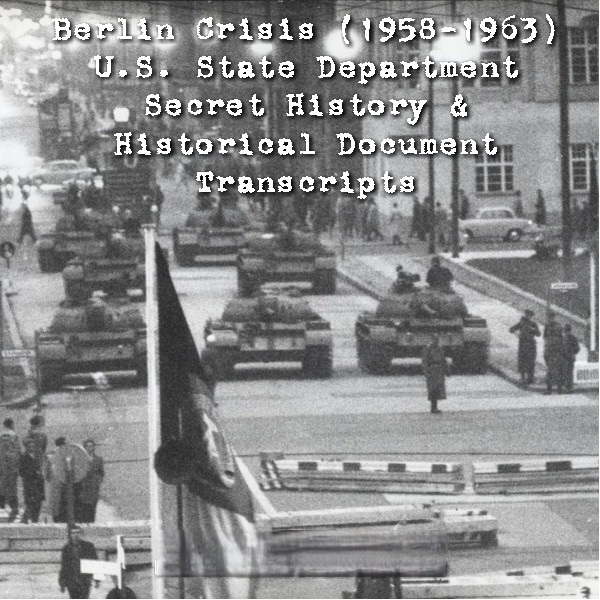
Berlin Crisis (1958-1963) US. State Dept Secret History & Documents Transcripts
$19.50
Description
The Berlin Crisis: A Detailed Timeline and Key Figures
Detailed Timeline of the Berlin Crisis (1958-1963)
November 10, 1958: Soviet Premier Nikita Khrushchev delivers a speech demanding that the Western powers (United States, Great Britain, and France) withdraw their forces from West Berlin within six months. This ultimatum marks the beginning of the Berlin Crisis.
November 27, 1958: The Soviet Union formally issues a note to the Western powers proposing to abolish the occupation regime in Berlin and transfer its functions to the German Democratic Republic (GDR).
January-March 1959: A series of diplomatic exchanges between the Western powers and the Soviet Union take place, leading to a proposal for a Foreign Ministers Meeting on Berlin.
May 11 – August 5, 1959: The Conference of the Foreign Ministers of the United States, the United Kingdom, France, and the Soviet Union is held in Geneva to discuss the Berlin issue. The conference ultimately fails to reach a resolution.
August 1959 – May 1960: Following the Geneva conference, preparations are made for a summit meeting between the leaders of the four powers.
May 16-20, 1960: The summit conference in Paris collapses shortly after it begins due to the U-2 spy plane incident involving the United States and the Soviet Union.
June 1960 – January 1961: Developments continue under the Eisenhower administration, with the Berlin issue remaining unresolved.
January – June 1961: The early phase of the Kennedy administration sees a renewed focus on the Berlin question.
June 3-4, 1961: President John F. Kennedy meets with Nikita Khrushchev in Vienna to discuss various issues, including Berlin, Laos, and disarmament. No solution is found for the Berlin problem, and Khrushchev reiterates his demand for Western withdrawal within six months.
July 1961: Following the Vienna summit, Kennedy responds to Khrushchev’s renewed ultimatum by activating 150,000 reservists and increasing defense expenditures, signaling a firm stance on West Berlin.
August 13, 1961: On the orders of East German leader Walter Ulbricht, the border between East and West Berlin is sealed off overnight with a barbed wire fence. This action, aimed at stopping the flow of East German migrants to the West and limiting Western influence, marks the beginning of the construction of the Berlin Wall.
August – September 1961: The barbed wire fence is rapidly expanded to include concrete walls and guard towers, solidifying the division of Berlin. Vice President Lyndon B. Johnson visits West Berlin, and General Lucius D. Clay is appointed as President Kennedy’s Special Representative to Berlin.
October 27, 1961: A tense confrontation occurs at Checkpoint Charlie when Soviet and U.S. tanks face each other only 100 yards apart. This event brings the world to the brink of a potential hot conflict during the Cold War.
October – November 1961: Negotiations and discussions continue between the four Western allies regarding potential talks with the Soviet Union.
December 1961 – March 1962: Initial meetings take place between U.S. Ambassador to the Soviet Union Llewellyn Thompson and Soviet Foreign Minister Andrei Gromyko to discuss Berlin. A crisis also develops concerning air access to Berlin.
March 1962: The Berlin issue is discussed at the Eighteen-Nation Disarmament Committee Meetings in Geneva.
April 1962 – June 1963: Further discussions and negotiations occur among the Western allies and with the Soviet Union on the status of Berlin.
June 1963: President John F. Kennedy visits West Berlin and delivers his famous “Ich bin ein Berliner” speech, reaffirming U.S. commitment to the city’s freedom.
June – December 1963: Talks continue in Moscow, New York, and Washington regarding Berlin. There are also incidents involving Allied convoys traveling to West Berlin. Chancellor Ludwig Erhard of West Germany visits the United States.
Cast of Characters and Brief Bios
- Nikita Khrushchev: (1894-1971) First Secretary of the Communist Party of the Soviet Union (1953-1964) and Chairman of the Council of Ministers (Premier) of the Soviet Union (1958-1964). He initiated the 1958 ultimatum demanding Western withdrawal from Berlin and played a central role in the unfolding crisis, including the decision to build the Berlin Wall.
- John F. Kennedy: (1917-1963) 35th President of the United States (1961-1963). He faced the height of the Berlin Crisis during his presidency, responding firmly to Soviet pressure and famously declaring “Ich bin ein Berliner,” symbolizing American solidarity with West Berlin.
- Walter Ulbricht: (1893-1973) First Secretary of the Socialist Unity Party (SED) and Chairman of the State Council of East Germany (GDR). He was instrumental in ordering the construction of the Berlin Wall to halt the emigration of East Germans to the West.
- Dwight D. Eisenhower: (1890-1969) 34th President of the United States (1953-1961). The initial Soviet ultimatum on Berlin was delivered during his administration, and his government formulated early responses to the crisis.
- Martin J. Hillenbrand: (1915-2005) A senior Foreign Service Officer and scholar of Germany in the U.S. State Department. He served as Deputy Head of the Berlin Task Force (BTF) and requested the comprehensive historical study of the Berlin Crisis from the State Department’s Historical Office. He later became the U.S. Minister to Bonn and Assistant Secretary of State for European and Eurasian Affairs, actively involved in reviewing and finalizing the study.
- Arthur Kogan: (Dates unknown) Historian in the U.S. State Department’s Historical Office. He was tasked with creating a detailed historical account of the Berlin Crisis at the request of Martin J. Hillenbrand. He conducted extensive research using classified documents and drafted the multi-part study.
- Edwin S. Costrell: (Dates unknown) Likely an official within the U.S. State Department who participated in discussions regarding the historical project on the Berlin Crisis with Hillenbrand and Kogan.
- Robert J. Manning: (1919-1998) Assistant Secretary of State for Public Affairs in the U.S. State Department. Hillenbrand corresponded with him regarding the importance and future use of the historical study on the Berlin Crisis.
- Lyndon B. Johnson: (1908-1973) Vice President of the United States under President Kennedy. He visited West Berlin shortly after the construction of the Wall to demonstrate American support.
- Lucius D. Clay: (1897-1978) A retired U.S. Army General who played a crucial role during the Berlin Blockade (1948-1949). President Kennedy appointed him as his Special Representative to Berlin during the 1961 crisis, lending his experience and authority to the situation.
- Andrei Gromyko: (1909-1989) Soviet diplomat who served as the Minister of Foreign Affairs of the Soviet Union for many years, including during the Berlin Crisis. He engaged in key negotiations with the Western powers, including U.S. Ambassador Thompson.
- Llewellyn Thompson: (1904-1972) United States Ambassador to the Soviet Union during a significant portion of the Cold War, including the Berlin Crisis. He held important discussions with Soviet Foreign Minister Gromyko regarding the situation in Berlin.
- Ludwig Erhard: (1897-1977) Chancellor of West Germany (Federal Republic of Germany) during the later part of the Berlin Crisis. His visit to the United States in 1963 highlights the close relationship between West Germany and the Western Allies during this period.
- Peter Fechter: (1944-1962) An 18-year-old East German who was shot and killed by East German border guards while trying to cross the Berlin Wall into West Berlin in August 1962. His death became a potent symbol of the brutality of the Wall and the division of Germany.
- Brandt (Willy Brandt): (1913-1992) Governing Mayor of West Berlin during the construction of the Berlin Wall and a prominent figure in expressing the city’s resilience and opposition to the division. His correspondence with President Kennedy reflects the close communication between West Berlin and the U.S.
Berlin Crisis (1958-1963) U.S. State Department Secret History & Historical Document Transcripts
5,219 pages of the State Department’s formerly secret history of the Berlin Crisis and Department of State transcripts of documents related to the Berlin Crisis.
Berlin Crisis (1958-1963)
On November 10, 1958, Soviet Premier Nikita Khrushchev delivered a speech in which he demanded that the Western powers of the United States, Great Britain and France pull their forces out of West Berlin within six months. This ultimatum sparked a three year crisis over the future of the city of Berlin that culminated in 1961 with the building of the Berlin Wall. The division of Germany and its capital city of Berlin among the four victors of the Second World War was frozen in time by the onset of the Cold War despite the postwar agreements to unify the zones.
In the summer of 1961, President John F. Kennedy met with Khrushchev in Vienna to address the ongoing issue of Berlin, in addition to the countries’ competing interests in Laos, and the question of disarmament. Although they agreed to further discussions on Laos, they found no solution to the Berlin problem. In the wake of the conference, Khrushchev once again gave the United States six months to withdraw from Berlin. Kennedy responded by activating 150,000 reservists and increasing defense expenditures, in preparation for a potential conflict over the future of the city. Unwilling to face a potential nuclear escalation over the city, Khrushchev prepared to take his own form of action.
On the morning of August 13, 1961, Berliners awoke to discover that on the orders of East German leader Walter Ulbricht, a barbed wire fence had gone up overnight separating West and East Berlin and preventing movement between the two sides. The barbed wire fence was soon expanded to include cement walls and guard towers. The Berlin Wall
would prevent the West from having further influence on the East, stop the flow of migrants out of the communist sector, and ultimately become the most iconic image of the Cold War in Europe.
On October 27, 1961, the Soviets deployed 10 tanks on their side of Checkpoint Charlie, and U.S. and Soviet tanks stood a mere 100 yards apart from each other. The confrontation made headlines around the world, and until Moscow and Washington mutually agreed to pull back, it looked as if the Cold War would become hot.
Documents
Crisis over Berlin – A Top Secret Study Produced by the State Department’s Historical Office.
677 pages of the Department of State, Bureau of Public Affairs, Office of the Historian Records, Research Project 614, “Crisis Over Berlin: American Policy Concerning the Soviet Threats to Berlin, November 1958-December 1962,” published in six parts between October 1966 and April 1970, and classified as “Top Secret.” The parts include:
Part I: Renewed Soviet Threats against Berlin and the Western Response, November 1958-April 1959
Part II: The Geneva Foreign Ministers Meeting, May-August 1959
Part III: From the End of the Geneva Foreign Ministers Meeting to the Abortive Summit Meeting, August 1958-May 1960
Part IV: Developments during the Final Phase of the Eisenhower Administration, June 1960-January 1961
Part V: Developments in the Early Phase of the Kennedy Administration and the Meeting with Khrushchev at Vienna, January-June 1961
Part VI: Deepening Crisis over Berlin: Communist Challenges and Western Responses, June-September 1961, (includes Documentary Appendix)
“Crisis over Berlin” was produced by the Historical Office of the Department of State at the request of Martin J. Hillenbrand, a senior Foreign Service Officer and scholar of Germany. Hillenbrand requested the document in his capacity as Deputy Head of the Berlin Task Force (BTF), an interagency body charged with coordinating responses to the Berlin Crisis.
Hillenbrand’s formal request of March 4, 1963 notes that the BTF found military histories of the crisis operationally helpful. Hillenbrand also hoped a State Department project focusing on the diplomatic aspects of the Berlin Crisis would also aid others in the future. Hillenbrand in a letter to Assistant Secretary for Public Affairs Robert J. Manning, on March 4, 1963, wrote that he hoped the study would be, “useful in the future when the history of this particular foreign policy problem comes to be written.”
The Historical Office accepted the task on March 22, 1963. Dr. Arthur Kogan was relieved of his other duties to fulfill Hillenbrand’s request. In a memorandum of conversation between Hillenbrand, Kogan, and Edwin S. Costrell dated April 1, 1963, Hillenbrand is recorded emphasizing the historical importance of the project, requesting a “thorough” account of “some length.”
Kogan received extensive access to highly classified Department of State documents for the purpose of creating a comprehensive account of the Crisis events. To address Hillenbrand’s request for a comprehensive account, Kogan designed an eight-part study covering the period November 1958-December 1962. Kogan transmitted the draft of Part I to Hillenbrand on August 21, 1964. Hillenbrand extensively involved himself in the project, critiquing Part I in detail. Kogan noted, “Your comments and suggestions regarding Part I were most helpful and they have been fully taken into account in the drafting of the final version.”
While waiting for Hillenbrand’s comments on Part I, Kogan finished drafts of Parts II, III, and IV. Hillenbrand, newly appointed Minister to Bonn, brought Kogan to Berlin in June 1965 so he could take an aerial tour of the city and speak to key actors in the Berlin crisis. Soon after the completion of this trip, Kogan was appointed Chief of the Research Guidance and Review Branch of the State Department’s Historical Office.
Kogan’s new duties prevented him from working extensively on the Berlin study; he noted regretfully on January 24, 1967 that Hillenbrand’s revisions to Parts II, III, IV, and V had not been included and that his work on the draft of Part VI was incomplete. Kogan sent Part VI to Hillenbrand on June 14, 1967. Writing that he would not be able to undertake the final two sections of the study, he expressed his belief that the present study, extending to September 1961, was sufficiently detailed to accomplish Hillenbrand’s goals.
The final copy of Part II was sent to Hillenbrand on August 11, 1969. The transmission letter for Part II stated that Parts III, IV, V, and VI, “will be given the final treatment before many months.” In March and April of 1970, Hillenbrand, who then was serving as Assistant Secretary of State for European and Eurasian Affairs (EUR), sent final versions of the Parts I through VI to senior officials in EUR, the Executive Secretariat to the Secretary of State, the United States Embassy in Bonn, and the National Security Council.
State Department Berlin Crisis Documents Transcripts
Foreign Relations of the United States, 1958–1960 Volume VIII Berlin Crisis, 1958–1959
Foreign Relations of the United States, 1958–1960 Volume IX Berlin Crisis, 1959–1960; Germany; Austria
Foreign Relations of the United States, 1961–1963 Volume XIV Berlin Crisis, 1961–1962
Foreign Relations of the United States, 1961–1963 Volume XV Berlin Crisis, 1962–1963
4542 pages, covering 1,412 documents in four volumes of the Foreign Relations of the United States (FRUS) series covering the Berlin Crisis. Produced by the Office of the Historian, Bureau of Public Affairs, United States Department of State, The FRUS series presents the official documentary historical record of major foreign policy decisions and significant diplomatic activity of the United States Government. These volumes document the facts and events that contributed to the formulation of policies and includes evidence of supporting and alternative views to the policy positions ultimately adopted.
The Berlin Crisis volumes present a comprehensive collection of the records of Presidents Eisenhower and Kennedy’s meetings with heads of state and government with respect to Berlin. Also presented are records of the principal negotiations on policy and military contingency planning regarding Germany and the Berlin Crisis that took place among the Western Allies as well as with representatives of the Soviet Union.
The Department of State historians focused on the major lines of the development of the Crisis, the editors have expanded the principles of selection adopted for previous volumes documenting the Berlin problem, focusing more extensively on its military aspects. They have also presented a record of the U.S. reaction and response to the major political events within the Federal Republic of Germany insofar as they figured directly in ongoing high-level political negotiations.
Intelligence information regarding Soviet intentions with respect to Berlin and Germany in general was vitally important during the Berlin Crisis and found its way into political documents the historians selected for publication. The editors did not, however, attempt to document any particular operational activities by intelligence authorities in connection with the German problem or to explore the scope and impact of intelligence operations.
Sections in the four volumes include:
August–December 1959: The status of Berlin following the Foreign Ministers conference August–December 1959; The Western summit December 19–21, 1959
Meeting of the Chiefs of State and Heads of Government of the United States, United Kingdom, France, and the Soviet Union (summit conference), May 16, 1960
December 1959-May 1960: Preparations for the Summit Conference
May 16–20, 1960: Proceedings of the summit conference and bilateral and tripartite discussions
Reports on the summit conference
January–October 1958: Continuing Soviet Harassment of Western Access to Berlin
November–December 1958: U.S. Response to Soviet Threats to Transfer its Functions in Berlin to the German Democratic Republic
Western Reaction to Khrushchev’s November 10 Speech
The Soviet Note of November 27 and the Western Replies of December 31
January–March 1959: Further Exchanges of Notes Leading to the Proposal for a Foreign Ministers Meeting on Berlin
The Soviet Note of January 10 and the western replies of February 16
February 17–March 30: Soviet Acceptance of the Western Proposal for a Foreign Ministers Meeting on Berlin
Conference of the Foreign Ministers of the United States, the United Kingdom, France, and the Soviet Union at Geneva May 11–August 5, 1959
March–May 1959: Preparations for the Conference
First Part of the Conference, May 11–June 20, 1959
June 21–July 12, 1959: Conference Recess
July 13–August 5, 1959: Second Part of the Conference
May–December 1960: Status of Berlin following the summit conference
January-May 1961: Consideration of the Question of Germany and Berlin
June-July 1961: The Summit Conference at Vienna June 3-4; NSAM No. 58; the Western Reply to the June 4 Soviet Aide-Memoire
July-August 1961: NSAM No. 62; the Second Acheson Report on Berlin; Meeting of the Four Western Foreign Ministers at Paris
August-September 1961: The Division of Berlin; the Brandt-Kennedy Correspondence; Vice President Johnson’s Trip to Berlin; General Clay’s Appointment as Special Representative to Berlin; NSAMs No. 92 and 94; Meeting of the Four Western Foreign Ministers at Washington
September-October 1961: Conversations with Foreign Minister Gromyko; Beginning of the Pal Correspondence
October-November 1961: The Crisis at the Friedrichstrasse Crossing
November-December 1961: Discussions among the Four Western Allies on Negotiations with the Soviet Union
December 1961-January 1962: First Meetings between Ambassador Thompson and Foreign Minister Gromyko
February-March 1962: Final Meetings between Ambassador Thompson and Foreign Minister Gromyko; Beginning of the Crisis over Air Access to Berlin
March 1962: Discussion of Berlin at the Eighteen-Nation Disarmament Committee Meetings at Geneva
April-May 1962: Differences between the United States and the Federal Republic of Germany
May–July 1962: Further Discussions in Washington, Geneva, and Moscow
August-September 1962: Contingency Planning, the Death of Peter Fechter, and the Abolition of the Office of the Soviet Commandant
September–November 1962: U.S. Policy on Berlin during the Cuban Missile Crisis
November 1962–January 1963: Allied Consideration of Resuming Talks with the Soviet Union
January–June 1963: Resumption of Talks with the Soviet Union and President Kennedy’s Trip to Germany
June-October 1963: Discussions at Moscow, New York, and Washington
October-December 1963: Convoy Incidents and Chancellor Erhard’s Visit to the United States






Related products
-
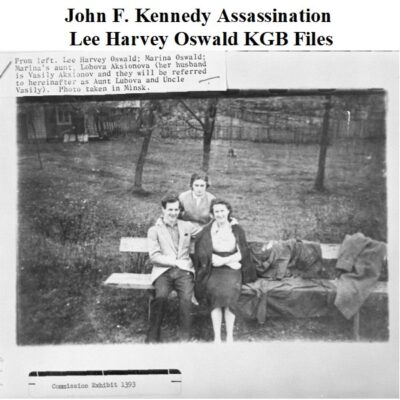
Lee Harvey Oswald KGB Files
$19.50 Add to Cart -
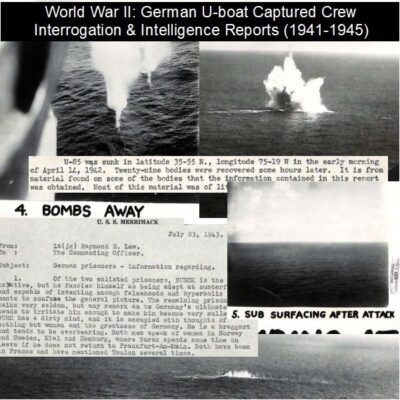
World War II: German U-boat Captured Crew Interrogation & Intelligence Reports (1941-1945)
$19.50 Add to Cart -
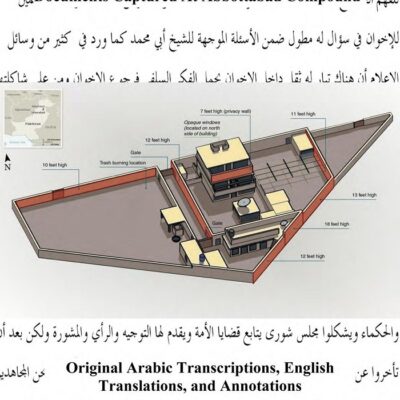
Osama Bin Ladin & Al Qaeda Documents Captured
$19.50 Add to Cart -
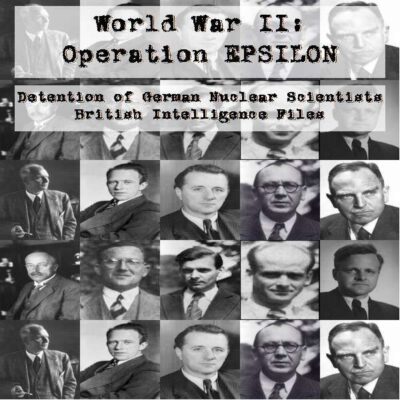
World War II: Operation EPSILON Detention of German Nuclear Scientists British Intelligence Files
$19.50 Add to Cart